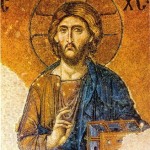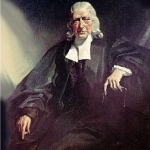The Image of the Invisible God – Colossians 1:15
 Exalted views of the Person of Christ arose quickly in the early Church. In the light of the resurrection, Jesus was recognized as the one who come to reveal — in his very person — the God of Creation. We need to remember that it was the resurrection event that gave rise to the Christian faith and the Christian Gospel as we know it. In the midst of the remembrance of Jesus’ birth and as we study Jesus’ life and teaching, we need to recall that the significance of Jesus’ life is revealed in the resurrection. No resurrection, no Christian faith. “If Christ has not been raised, your faith is futile and you are still in your sins.” (1 Corinthians 15:17 NRSV.)
Exalted views of the Person of Christ arose quickly in the early Church. In the light of the resurrection, Jesus was recognized as the one who come to reveal — in his very person — the God of Creation. We need to remember that it was the resurrection event that gave rise to the Christian faith and the Christian Gospel as we know it. In the midst of the remembrance of Jesus’ birth and as we study Jesus’ life and teaching, we need to recall that the significance of Jesus’ life is revealed in the resurrection. No resurrection, no Christian faith. “If Christ has not been raised, your faith is futile and you are still in your sins.” (1 Corinthians 15:17 NRSV.)
And this exalted view of Christ is what we find in the letter to the Colossians. In verse 15 we read:
ὅς ἐστιν εἰκὼν τοῦ θεοῦ τοῦ ἀοράτου, πρωτότοκος πάσης κτίσεως,
“He is the image of the invisible God, the firstborn of all creation;” (NRSV).
Within the study of early Christianity, the notion sometimes arises that there was a growing evolutionary development in the ideas about Christ. Originally, it is thought, the Christian movement was attached to the human Jesus of Nazareth, and more exalted ideas about Christ’s deity (Jesus’ oneness with God) developed slowly, over time, from reflection on the faith-implications of Jesus’ earthly life.
This picture is wrong.
If the resurrection of Christ was the basis of the early Church’s proclamation of Jesus, we should expect the very opposite. The Gospel message was based in the fact that Jesus’ life was a visitation from God — a revelation of God — in the light of Christ’s resurrection from the dead. It was in the light of the resurrection that Jesus’ earthly life and teaching and path to the Cross became the basis of a message of hope.
So, if this is true, we should expect the very opposite to be the case: exalted views of the deity of Christ precede sustained reflection on Jesus’ earthly path, and the significance of his life and teaching. (We must always remember that even the Gospels of Matthew, Mark, Luke and John are reflections on the life of Jesus from the standpoint of the Easter faith. They are simply historical documents and memories, they are statements of faith.)
In this video, Dr. Larry Hurtado reflects upon this. We find that the exalted views of Jesus’ deity arose early in the history of the Christian faith. They are not simply a late development.
[kad_youtube url=”https://youtu.be/pLeXpSCLrD8″ ]
Christ in Relation to the Invisible God.
Christ is “the image of the invisible God” (εἰκὼν τοῦ θεοῦ τοῦ ἀοράτου). In his rebuttal to the Colossian “worship of angels”, Paul directs their attention to Jesus Christ. Christ is the focus of our faith. Compare this statement about the exalted place of Christ with other such statements in the New Testament: John 1:1-14, Hebrews 1:1-4, 1 John 1:1-4. The early Christian message was a message about Christ. The story of Jesus life, death and resurrection was the basis of the message of reconciliation with God.
John Wesley comments: “By describing the glory of Christ, and his pre-eminence over the highest angels, the apostle here lays a foundation for the reproof of all worshippers of angels.”
There are some scholars who feel that this section on the greatness of Christ in the letter to the Colossians is a quotation of a pre-Pauline hymn to Christ.
While this is far from proven (and seems a bit unlikely to me) it would not be strange for Paul to adopt language and imagery that was already familiar to his readers. He is reminding them of what their Christian faith is and always was.
The Scriptures tells that no one has ever seen God, it is Christ who has revealed God: “No one has ever seen God. It is God the only Son, who is close to the Father’s heart, who has made him known.” (John 1:18 NRSV) That is the idea here: in Christ, the Invisible has become visible and known. Christ has revealed what God is like.
The apostle Paul also uses the phrase εἰκὼν τοῦ θεοῦ (“image of God”) to speak of Christ in 2 Corinthians 4:4. As Christians, we see God through Christ.
 The theological way to express this idea is to say that Christ is the self-revelation of God. In Christ God reveals Himself. Statements like this, of course eventually led the Church to confessions like the Nicene Creed and to the formulation of the doctrine of the Trinity. Jesus was God in human flesh: God revealing God’s self. (Notice how language begins to fail in trying to express this.) “[Jesus Christ] is the reflection of God’s glory and the exact imprint of God’s very being, and he sustains all things by his powerful word. When he had made purification for sins, he sat down at the right hand of the Majesty on high, having become as much superior to angels as the name he has inherited is more excellent than theirs.” (Hebrews 1:3, 4 NRSV).
The theological way to express this idea is to say that Christ is the self-revelation of God. In Christ God reveals Himself. Statements like this, of course eventually led the Church to confessions like the Nicene Creed and to the formulation of the doctrine of the Trinity. Jesus was God in human flesh: God revealing God’s self. (Notice how language begins to fail in trying to express this.) “[Jesus Christ] is the reflection of God’s glory and the exact imprint of God’s very being, and he sustains all things by his powerful word. When he had made purification for sins, he sat down at the right hand of the Majesty on high, having become as much superior to angels as the name he has inherited is more excellent than theirs.” (Hebrews 1:3, 4 NRSV).
Christ in relation to all Creation.
Christ is “the firstborn of all creation” (πρωτότοκος πάσης κτίσεως). This phrase seems to me to express pre-eminence over all creation. It is not time-sequence so much that is in mind here, but Christ’s position in relation to all creation. Verses 16, 17 show us how this phrase is to be understood. Christ is not a created thing/being but the one by whom all things/beings were created. So, Paul writes in Philippians 2:9: “Therefore God also highly exalted [Jesus Christ] and gave him the name that is above every name….”
The reference is to the rights and position of that the firstborn had in the Biblical world. Christ has supremacy in rank over all the rest of creation. Thus, it is right to give praise to the Son as well as the Father.
“Ye servants of God, your Master proclaim,
and publish abroad his wonderful name;
the name all-victorious of Jesus extol,
his kingdom is glorious and rules over all.
“God ruleth on high, almighty to save,
and still he is nigh, his presence we have;
the great congregation his triumph shall sing,
ascribing salvation to Jesus, our King.
“’Salvation to God, who sits on the throne!’
Let all cry aloud and honor the Son;
the praises of Jesus the angels proclaim,
fall down on their faces and worship the Lamb.
“Then let us adore and give him his right,
all glory and power, all wisdom and might;
all honor and blessing with angels above,
and thanks never ceasing and infinite love.”
— Charles Wesley
















So good to be reminded again of the basis for this Christology Thanks so much